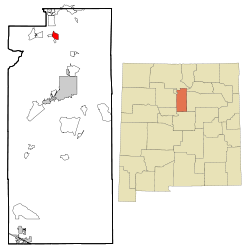Pojoaque
| Pojoaque, New Mexico | |
|---|---|
| CDP | |
 Location of Pojoaque, New Mexico. |
|
| Location in the United States | |
| Coordinates: 35°53′26″N 106°0′34″W / 35.89056°N 106.00944°WCoordinates: 35°53′26″N 106°0′34″W / 35.89056°N 106.00944°W | |
| Country | United States |
| State | New Mexico |
| County | Santa Fe |
| Area | |
| • Total | 2.9 sq mi (7.5 km2) |
| • Land | 2.9 sq mi (7.5 km2) |
| • Water | 0.0 sq mi (0.0 km2) |
| Elevation | 5,853 ft (1,784 m) |
| Population (2000) | |
| • Total | 1,261 |
| • Density | 437.3/sq mi (168.8/km2) |
| Time zone | Mountain (MST) (UTC-7) |
| • Summer (DST) | MDT (UTC-6) |
| ZIP code | 87501 |
| Area code(s) | 505 |
| FIPS code | 35-58630 |
| GNIS feature ID | 0928773 |
|
|
Pojoaque (/pəˈwɑːkiː/; Tewa: P'osuwaege Owingeh [p’òhsũ̀wæ̃̀gè ʔówîŋgè]) is a census-designated place (CDP) in Santa Fe County, New Mexico, United States. It is part of the Santa Fe, New Mexico Metropolitan Statistical Area. The population was 1,907 at the 2010 census. Pojoaque Pueblo, a neighboring community, is an Indian Reservation, and the town of Pojoaque is a collection of communities near the Pueblo with people from various ethnic backgrounds. The area of Pojoaque includes the neighborhoods of Cuyamungue, Jacona, Jaconita, Nambé and El Rancho.
In the early 17th century the first Spanish mission San Francisco de Pojoaque was founded. During the Pueblo Revolt of 1680, Pojoaque was abandoned, and was not resettled until about 1706. By 1712 the population had reached 79. During the revolt of 1837, New Mexico native Manuel Armijo defeated of the rebels at Puertocito Pojoaque, east of Santa Cruz de la Cañada. In the early 1900s the Pojoaque Valley School District was established to serve the educational needs of the valley.
Pojoaque Pueblo is one of the six Tewa-speaking Rio Grande Pueblos, and a member of the Eight Northern Pueblos. The Pueblo was settled around 500 AD, with the population peaking in the 15th and 16th centuries.
In about 1900, a severe smallpox epidemic caused the pueblo to be abandoned once again by 1912. In 1934, Pojoaque Pueblo was reoccupied, and became a federally recognized Indian Reservation in 1936.
...
Wikipedia

